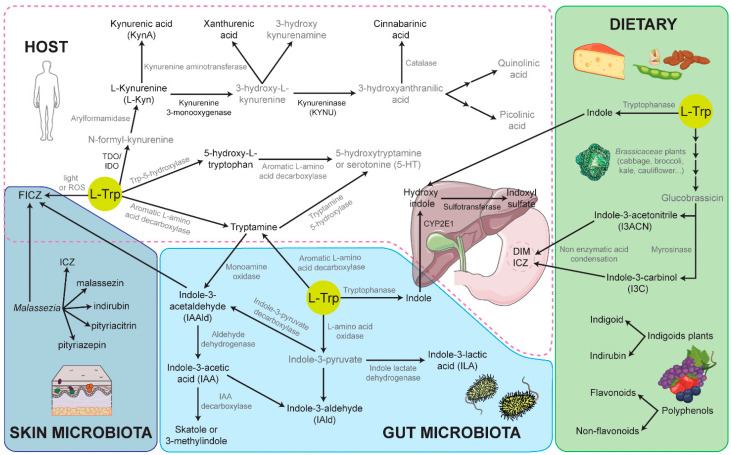Figure 3.
Summary of natural AHR agonist synthesis pathways in mammalian cells, associated microbiota, and dietary plants. HOST—endogenous L-tryptophan (L-Trp) metabolism via the L-kynurenine (L-Kyn), serotonin (5-HT), and tryptamine pathways; indoxyl synthesis in the liver from the diet- or microbial-derived indoles; gastric acid condensation of dietary indoles pro-ligands produces high-affinity indolic agonists; 6-formylindolo [3,2-b]carbazole (FICZ) is generated by L-Trp photo-oxidation, L-Trp chemical-oxidation, or by enzymatic deamination of tryptamine that yields the precursor indole-3-acetaldehyde (IAAld). SKIN MICROBIOTA—the AHR agonist, synthesized by skin-resident microbiota, such as Malassezia yeast species. GUT MICROBIOTA—indole-derived AHR agonists, provided by microbial metabolism of L-Trp, which can be further metabolized to indoxyl by the host. DIETARY—polyphenol- and indole (e.g., Brassicaceae plants)-rich foods provide exogenous ligands, either as direct AHR ligands or as pro-ligands that can be converted to AHR ligands by the host. L-Trp metabolic routes have been designed according to the KEGG Pathway Database (https://www.genome.jp/kegg/pathway/map/hsa00380.html (accessed on 8 October 2021) and PathBank (https://pathbank.org/view/SMP0000063 (accessed on 8 October 2021)). AHR ligands or enzymes regulated by AHR are indicated in black, and intermediate molecules and enzymes are in grey.

